Part 7 - Kobe Day 2 (Kyoto), Japan

Part 7 - Kobe Day 2 (Kyoto)
After the eventful day before, we woke up full of anticipation again, as we had planned a tour to Kyoto. Stop, that’s not quite correct. It was Kate, one of the two young ladies from London, who had booked this tour. When we were in touch before the cruise, it turned out that they had planned a tour to Kyoto on the second day in Kobe, and we had planned a tour to Osaka on the first day, so our plans really complemented each other.
At 8.00 am we met in the lobby together with two other couples from Missouri and Arizona before we all got off the ship to meet Ken, our guide for the day, in the terminal.
Ken greeted us warmly in excellent English and called the driver of our van. A few minutes later, we were picked up right at the door by a very spacious and comfortable minivan, which left nothing to be desired. We even had free Wifi on board.
During the approximately one-hour drive to Kyoto, Ken gave us valuable insight into the country, its people and its history but was in turn also very keen to learn what we had to tell from our respective home countries.
So time went by quickly and we soon reached our first destination of the day – Nijo-jo Castle, the more than 400-year-old World Cultural Heritage.
Once again, the castle was another legacy of our old friend shogun Tokugawa Ieyasu. He had commissioned its construction in 1601.

In 1603 he first set foot in the castle. Maybe even through the Higashi Ote-mon gate, the eastern gate through which we now entered the castle at the outer moat in bright sunshine some 400 years later.

We noticed immediately that here – just like in the other places we had visited the days before – everything seemed very well maintained and newly renovated.

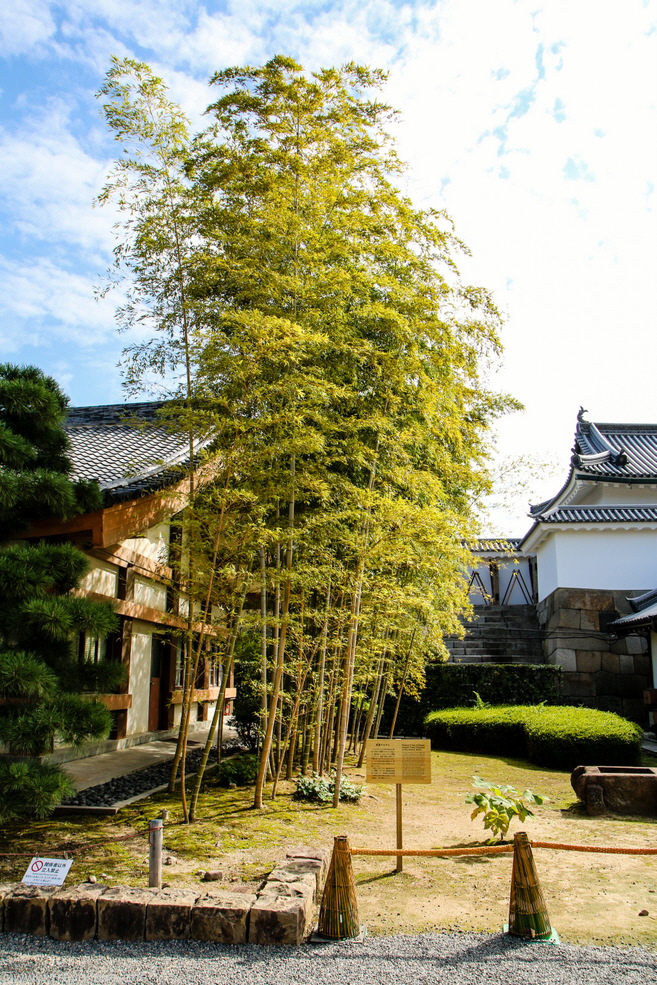
And yet we weren’t prepared for the splendor glistening in the sun that awaited us at the entrance gate of Ninomaru Palace in the inner area of the castle. The architecture of the gates represented a certain status at the time, of which the Karamon Gate in Chinese style was the highest possible.

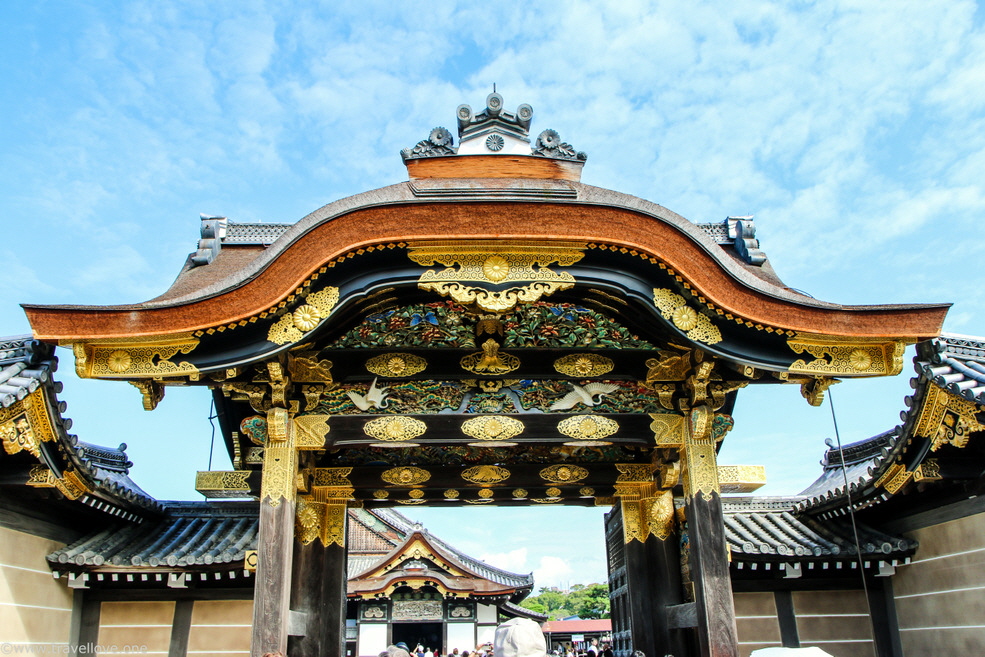
As usual, the impressive ornaments and details all had symbolic meanings. Brilliantly painted carvings of cranes, pines, bamboos and plum blossoms stood for longevity. Magnificent lions and tigers guarded the palace.


A good spot for a group photo with Ken, our guide.

We eagerly turned to Ninomaru Palace which consists of six buildings lined up next to one another, all beautifully decorated of course.



Before we entered the palace, Ken provided us with further details and facts.

Inside the building there were different rooms with different functions: reception rooms, meeting rooms, living quarters of the shogun etc. What they all had in common was beautifully painted paper walls and intricately carved ceiling beams. Unfortunately, photography wasn’t allowed inside, so here are some pictures from the website.


Outside, the palace was surrounded by a beautifully landscaped, extensive garden with a pond landscape.




On the side of the building we had the opportunity to look under one of the floor slabs and take a closer look at one particular technical detail. When visiting the rooms in the palace, we were accompanied by a constant squeak of wooden floor panels, which sounded like the chirping of birds. This noise is the reason why those floors are called Uguisu Bari – nightingale floors.
The myth that this was a deliberate design to serve as some kind of alarm system is, unfortunately, wrong. Fact is that due to the movement of the wood, the brackets simply rub on the nails, but that wasn’t intended.
Here we could see these brackets from below.

A bridge across the inner moat and a path through another heavy gate connected this side of Ninomaru Palace with the central Honmaru Palace. Which we didn’t visit though.


Instead, we returned to the east gate, where our driver picked us up. As it was too early for our lunch, Ken added an impromptu visit of another shrine.
However, the visit of the Kitano Tenmangu Shrine was anything but a stopgap. For over 1000 years, the scholar Sugawara no Michizane has been worshipped here. Even today, pupils and students pray for better grades and the passing of exams.
We entered the complex through the impressive two-story gate. The inscription on the sign above the gate reads “To the Founder of Learning and Poetry”.


One path led through the Sankomon gate, also known as Middle Gate.
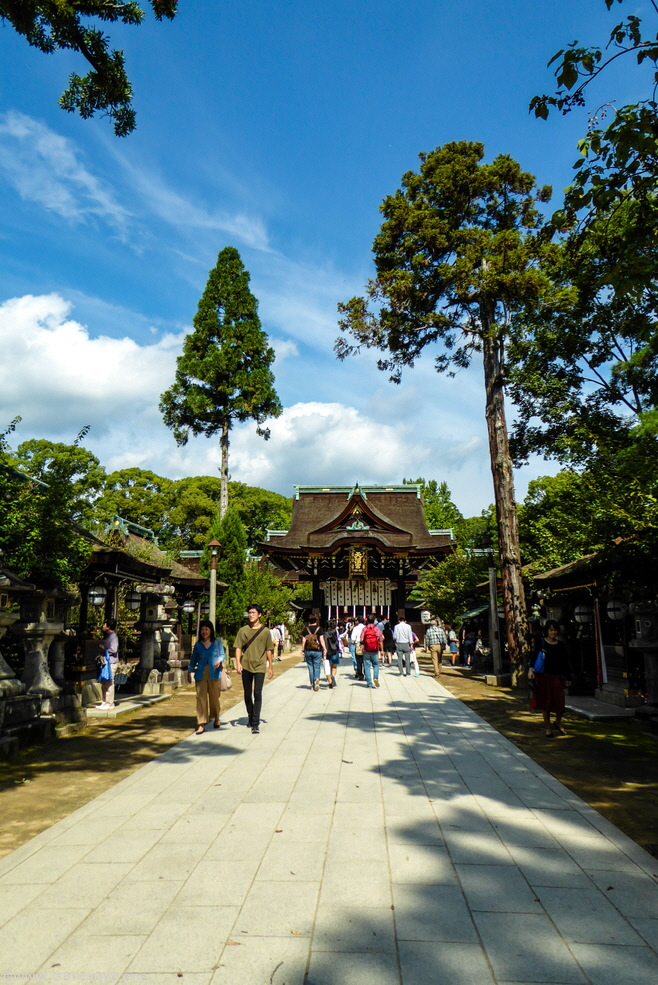

At the side of the path we saw more small shrines, sculptures and buildings.
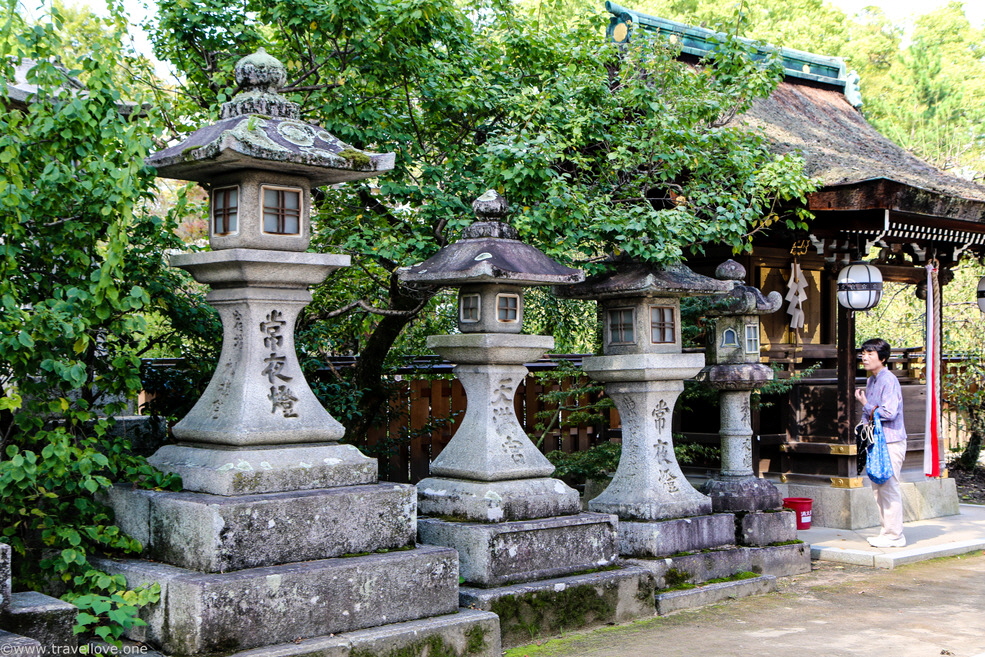


This one was dedicated to the “God of Thunder”, as Sugawara was also called at times.

Through this gate we reached the large courtyard in front of the entrance hall of the actual shrine.

In the meantime, the restaurant where Ken had booked us for lunch had opened. Here we took a well-deserved break and enjoyed a delicious Japanese meal.


From the restaurant we could walk directly to our next destination. We didn’t know then that the impressions we’d take away from there would still be “images of Japan” in our minds today.
Kinkaku-ji, the Golden Pavilion, is located in the northwest of Kyoto and describes a pavilion covered in gold leaf. It was built in 1397 by shogun Ashikaga Yoshimitsu as part of the construction of a lavish temple and residential complex. Originally it served as a relics hall. After Yoshimitu’s death the pavilion was turned into a Zen temple. Its official name is Rojion-ji (“Doe Garden Temple”), but it is better known as the Golden Pavilion.
Through yet another gate (it should actually be called: Japan - land of the gates), we reached the complex and a very beautiful garden in its outer area.

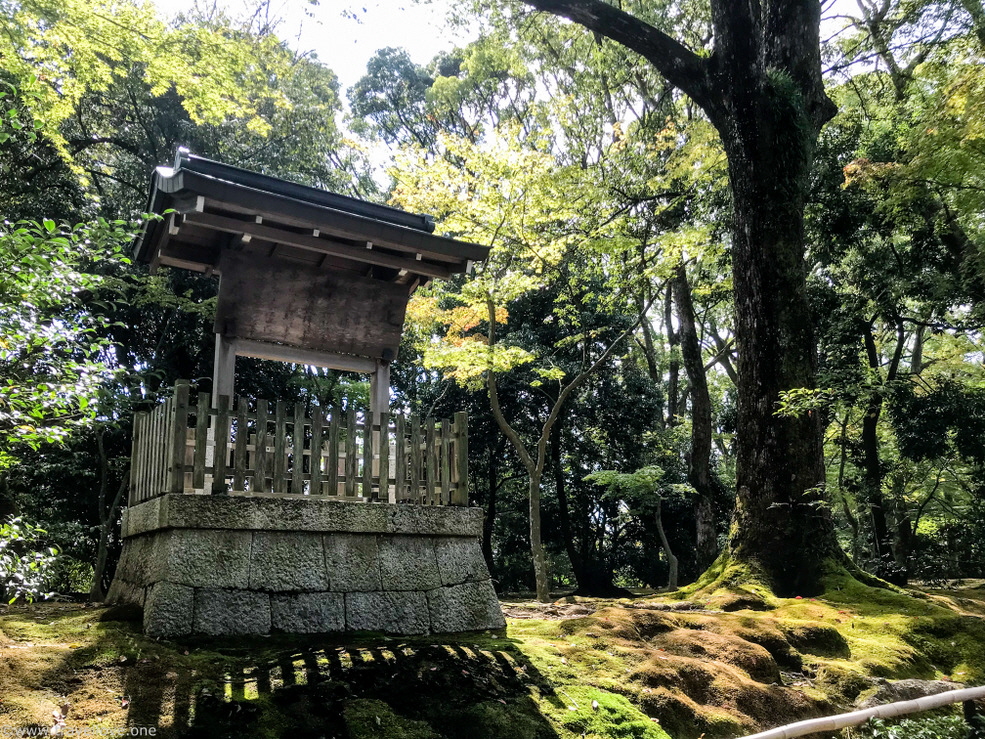
When the wooded garden opened, we were presented with a breathtakingly beautiful view. A large lake with deep green water reflecting a golden pavilion built on the opposite shore.

Discreetly embedded in its natural environment on purpose, the pavilion, despite its splendor, doesn’t glaringly stand out but nestles discreetly in the natural landscape. This corresponds to the aesthetic sense of the time, according to which gardens and temples should blend into their natural environment with as little contrast as possible and thus create a harmonious relationship between nature and man.

We rounded the lake and approached the pavilion.
The building’s architecture was characterized by various Japanese and Chinese architectural styles. The pavilion is made up of three floors framed by balconies.


The trees on the little islands in the lake seemed to have copied the pavilion and grew in terraces.
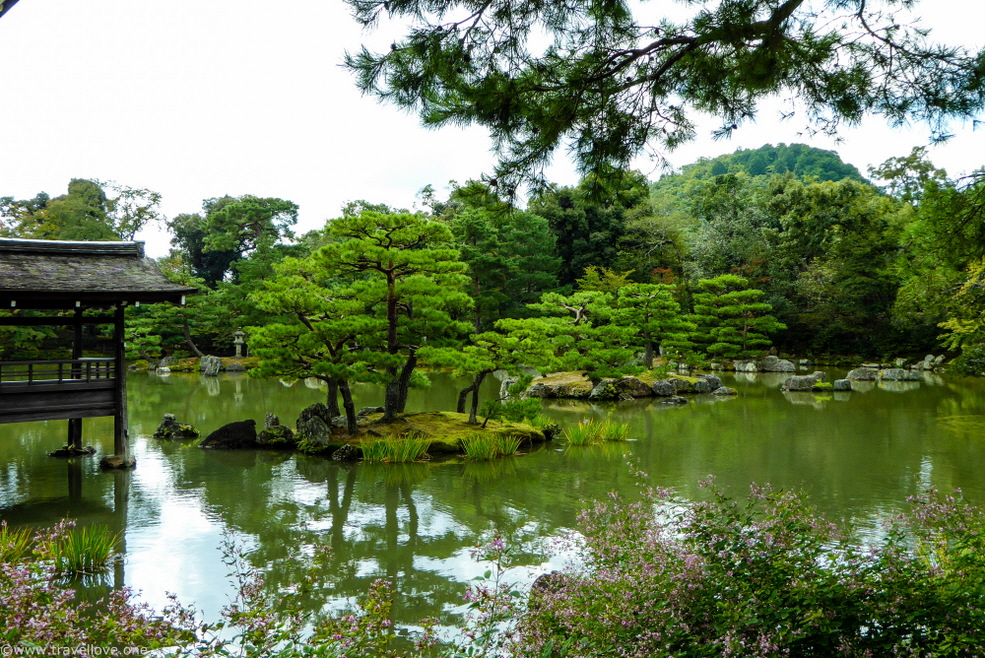
The former residential buildings of the temple’s high priest were located at the side of the lake.


Behind the temple, a narrow path led up the hill and past a little spring. They say that this is where the water for the tea ceremony was collected at the time.

On top of the hill we reached another small lake. A couple in colorful traditional clothes formed a nice contrast to the green of nature.


At the end of this path Ken showed us an old tea house, which was preserved near a smaller shrine and some souvenir shops.

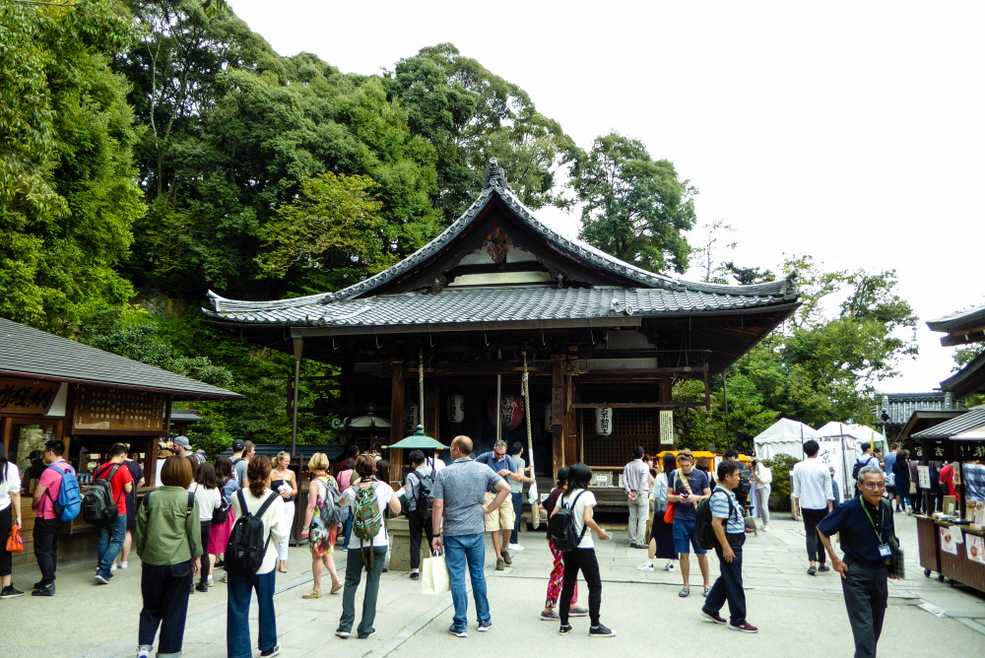
Our next destination was Ryoanji temple. Originally built as a country house of a wealthy family, the grounds were acquired by a civil servant around 1450, who founded a Zen temple there.
The area includes another extensive park and a big lake.


A small bridge and a path led to one of three little islands that hosted a small shrine.




Ryoanji temple is one of the largest schools of Rinzai-Zen. It is mainly visited for its Zen garden (kare sansui), which is one of the most famous of its kind. The garden consists only of stones in various sizes – no water, no plants. Lost in the symbolic infinity of the sea of white pebbles, it is adorned by a total of fifteen little islands of basalt stones.


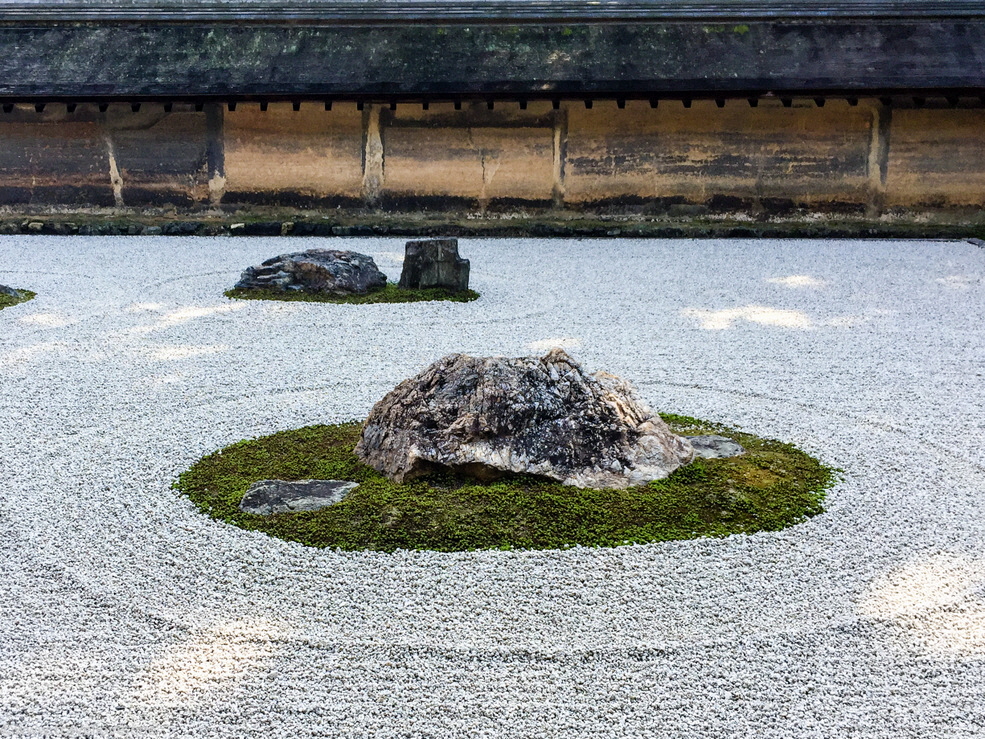
There is no place from where all fifteen stones can be seen at once. They are arranged so that the visitor can see a maximum of fourteen at a time.
You can see the garden from the Hojo, the residential building of the high priest. Again, the rooms of the Hojo and their painted sliding doors could only be viewed from the outside.

There is another garden on the other side of the Hojo. With its green, dense plants it forms a nice counterpart to the barren but no less beautiful rock garden.



We left the temple via a footpath. A small path branched off from it towards a restaurant known for a popular Kyoto tofu specialty. Ken took us along that path to show us the beautiful gardens in which the restaurant was located.

At the exit of the temple we were greeted by many colorful shops. You could buy anything from colorful kimonos to all sorts of green matcha products.


To return to the parking lot, where our driver was waiting for us, we strolled along the “Philosopher’s Path” which is said to be one of the most beautiful places during the cherry blossom season.

We didn’t think that the day could hold any more highlights for us, but Ken upped the ante by taking us to Ginkaku-ji temple. The complex is called “Silver Pavilion”. It was originally built in 1482 as a retirement home by the shogun Ashikaga Yoshimasa – in reference to the “Golden Pavilion” of his grandfather. After his death it was converted into a Zen temple in 1490.

The pavilion itself, as opposed to its name, is by no means decorated with silver. They say it got its nickname because the originally black lacquered buildings appeared like silver in the moonlight.

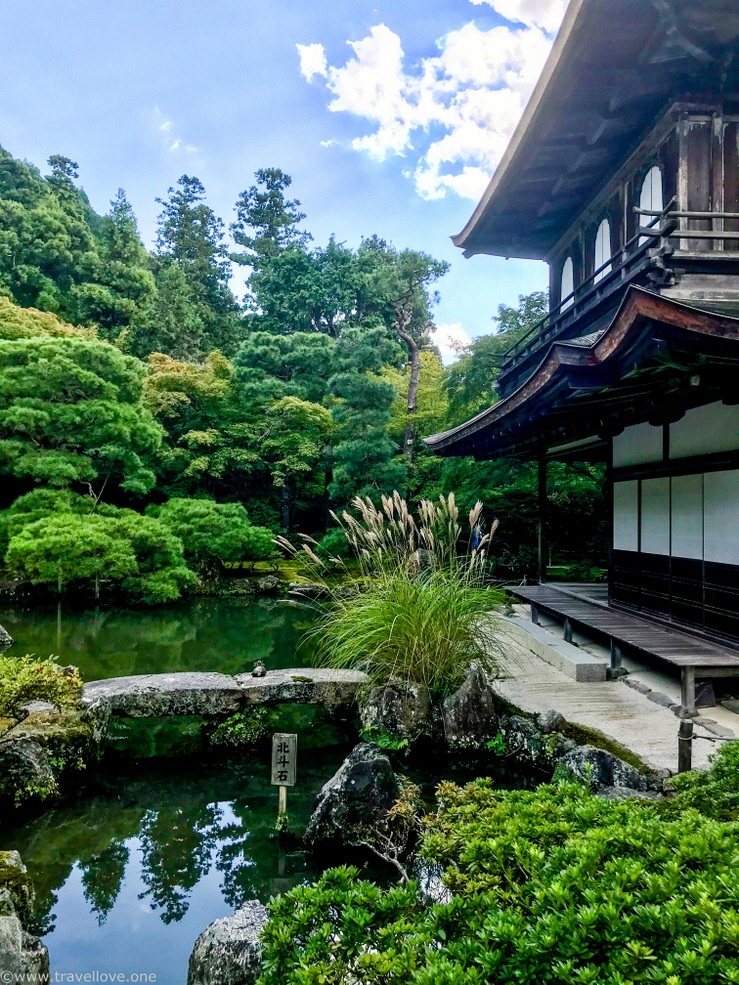

In front of the Silver Pavilion lies a perfectly maintained sand garden, known as “Sea of Silver Sand” with a large sand cone called “Moon Viewing Platform”.



But the sand garden wasn’t the only garden. A beautiful landscape of lakes, streams, Japanese pieris, trees and palm trees spread out between the buildings and stirred the blood of any garden aficionado.


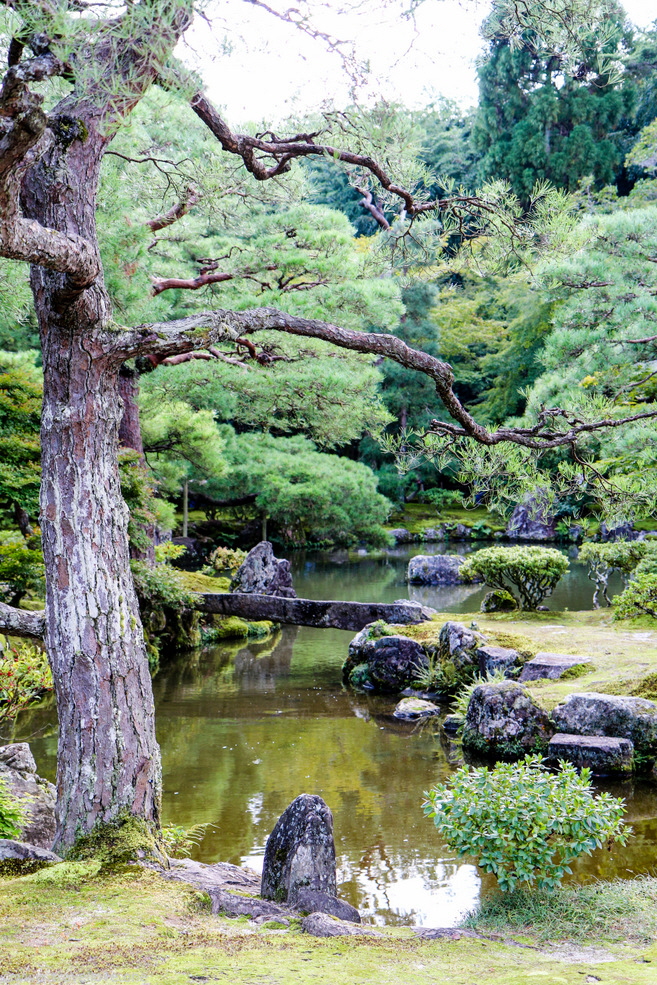


We took one of the garden paths to climb the side of a hill to a viewpoint from where we could overlook the complex.

On the way to our final destination we made a quick photo stop in front of the big portal of the Chion-in Temple, one of the film locations from the movie “The Last Samurai” with Tom Cruise.

Our actual destination was the Gion district. For many centuries, the district had become the largest, most prominent and distinguished center of Japanese geisha culture. A geisha (here also called geiko or, if in training, maiko) has to master traditional Japanese arts such as calligraphy and playing several Japanese instruments. She must be skilled in the art of conversation, a perfect hostess and she must master song, dance and the art of the tea ceremony.
In the traditional buildings of the neighborhood you can still be entertained by geishas today. However, non-tourist functions will be rather high-priced events.
Ken walked us through a part of the neighborhood with its old wooden houses.



The neighborhood is also popular with the Japanese, who come here to celebrate weddings or enjoy it from a rickshaw.


They say that if you are lucky, you might also meet a geisha and can (respectfully) take a photo of her. We were lucky and were able to photograph a geisha, or in this case a maiko. A final highlight.


After our return to Kobe, we had a drink on the deck of the Sunset Bar, which was truly living up to its name.

After dinner at around 9.30 pm, it was time to leave and the Millennium set sail. Even at this time there were many onlookers on the terrace of the terminal waving us a friendly goodbye.


By now it was official: Japan was deeply locked in our hearts. And Ken, our guide, had done a lot to contribute to it.

www.travellove.one • www.thecruise.report • www.travelandcruise.net
© 2021 Die Rechte an Texten, Fotos und Videos liegen beim Autor der Webseite. Die Nutzung ist nur nach ausdrücklicher Freigabe erlaubt.
